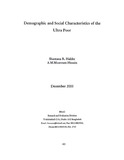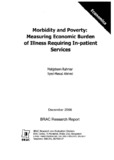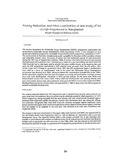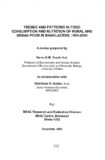Browsing by Subject "Poverty--Bangladesh."
Now showing items 1-20 of 20
-
Attitudes of the Elite Groups towards the ultra-poor: secondary stakeholders in the CFPR-TUP
(BRAC Research and Evaluation Division (RED), 2003)"Attitudes of the Elite Groups towards the Ultra-Poor Secondary stakeholders in the CFPR-TUP" was initiated as a combined effort between Advocacy and RED. Secondary stakeholders are those that beyond the primary stakeholders ... -
Demographic and social characteristics of the ultra poor
(Research and Evaluation Division, Brac, 2000-12)This report aimed to understand the demographic, social and economic characteristics of the ultra poor. Analysis of data clearly showed that the ultra poor households were smaller in size than the rural average. One-third ... -
The extreme poverty in Bangladesh: an overview
(Research and Evaluation Division, Brac, 2000-12)By reviewing existing literature this report focuses on methodological issues related to the identification of ultra poor in Bangladesh. According to different statistics up to 40% of the rural poor in Bangladesh remains ... -
Female-headed households and the ultra poor in Bangladesh
(Research and Evaluation Division, Brac, 2000-12)This report focuses on the magnitude of FHHs among the poorest and examines their socio-economic profile to highlight the distinction between FHHs and the entire sample. Female-headed households (FHHs) are of two types: ... -
Food security and the ultra poor
(Research and Evaluation Division, Brac, 2000-12)This paper aims to derive some policy guidelines by analysing factors affecting food security of the ultra poor. Here more emphasis is given on the number of rice meals taken and the sources of rice consumed during the ... -
Income status of the ultra poor
(Research and Evaluation Division, Brac, 2000-12)This paper reports on income status, major sources of income and determinants of income of the ultra poor Mean per capita income was calculated to be Tk.3,385, per annum that was even less than the estimated lower poverty ... -
Listening to the "Extreme Poor": IGVGD participants speak on their success
(Research and Evaluation Division, Brac, 2000-07)Those dealing with the issues of poverty and development have recently acknowledged the heterogeneity of the poor. The extreme poor rest on the other side of this poverty spectrum. Women in the extreme poor households ... -
Morbidity and poverty measuring economic burden of illness requiring inpatient services
(BRAC Research and Evaluation Division (RED), 2006-12)Severe illnesses may have important consequences for the poor in terms of the costs of treatment they have to bear and income erosion effects of those illnesses. The resulting depletion of wealth may also transmit poverty ... -
NGO intervention and the ultra poor
(Research and Evaluation Division, Brac, 2000-12)This report mainly discusses the perceptions of the ultra poor regarding NGO membership and their future development needs if they join NGOs like BRAC. It also focuses on reasons for membership discontinuation, issues ... -
Poverty alleviation programmes reduce inequities in health : evidence from Bangladesh*
(BRAC Research and Evaluation Division (RED), 1999)Over the previous two decades many poverty alleviation programmes have been implemented in developing countries. Evaluation of such programmes have traditionally looked at their success in increasing the income levels ... -
Poverty outreach and BRAC’s microfinance interventions programme impact and sustainability
(BRAC Research and Evaluation Division (RED), 2003)This paper is based on the experience and evolution of a large microfinance provider BRAC - which is working in Bangladesh. The paper stresses that poverty is not homogeneous, but is manifested in different ways and in ... -
Poverty reduction and MDG localization: a case study of the IGVGD Programme in Bangladesh
(BRAC Research and Evaluation Division (RED), 2007) -
Poverty status and differential access to health services in RDHC area
(BRAC Research and Evaluation Division (RED), 2001-12) -
The process of poverty and the ultra poor
(Research and Evaluation Division, Brac, 2000-12)This report focuses on the poverty process - how they become poor, the reasons for their falling into poverty. Poverty is multi-causal. On average 1.7 causes were identified by the respondents. Major causes of poverty ... -
Providing the urban poor with water and sanitation: an introduction
(BRAC Research and Evaluation Division (RED), 1999) -
Selected living standard indicators and the ultra poor
(Research and Evaluation Division, Brac, 2000-12)This report aimed to give a clear picture on the nature of their vulnerability and potentiality to cope wit by analysis their non-land asset base, ownership of savings and their level of human poverty. It was estimated ... -
Trends and patterns in food consumption and nutrition of rural and urban poor in Bangladesh, 1991-2000
(BRAC Research and Evaluation Division (RED), 2002-12)A review report is prepared on the trends and patterns of food intake and nutritional status of the poor rural and urban households of Bangladesh during the decade of 1991-2000. Because agricultural production is the ... -
The ultra poor in the capital market
(Research and Evaluation Division, Brac, 2000-12)This paper looks into the issue of accessibility of the capital market for the ultra poor by analyzing the extent of borrowing, their sources and uses of loan. One-fourth had access to any capital sources, and only about ... -
The urban poor in Dhaka City: their struggles and coping strategies during the floods
(BRAC Research and Evaluation Division (RED), 1998-09)Poorer groups are exposed to increased vulnerabilities during periods of floods. Some of the difficulties faced by them include loss of possessions, fears of extortion and looting, and separation from their social network. ...




















